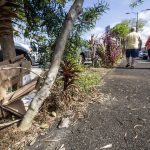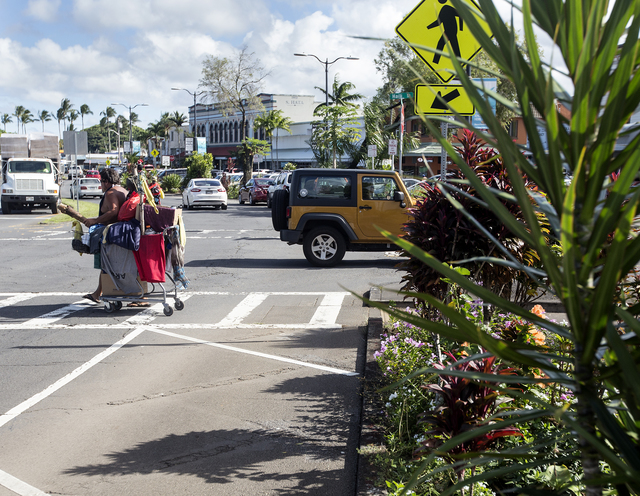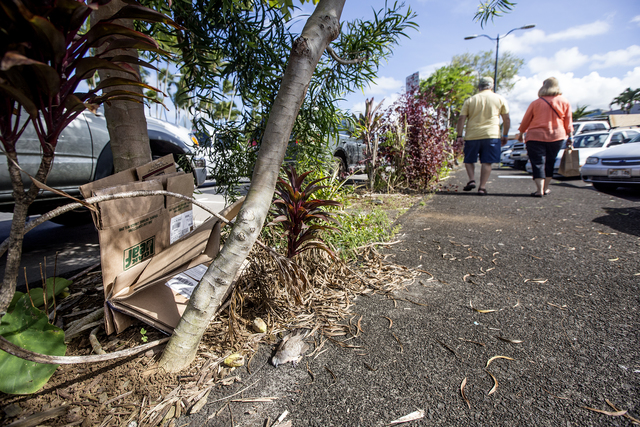A Facebook post about Downtown Hilo beautification quickly evolved into an outcry from residents who fear radical removal of trees, plants, planters and other downtown amenities.
“On Oct. 18th, members of the Hilo Downtown Improvement Association walked along Downtown Hilo’s streets with County Public Works personnel and members of our community police to identify areas of concern,” says a post on the page www.facebook.com/downtownhilo. “The vegetation in certain areas of concern will be replaced with vegetation that would discourage defecation, urination, littering, and storage of personal items.”
Frustration with the implication that homelessness is the cause of problem, rather than a problem in need of a solution, boiled over onto a separate Facebook post and into the halls of the Tsunami Museum, with heard-it-on-the-grapevine conversations focused on worries that swaths of shrubbery, trees and perhaps even stone walls might be summarily removed in the middle of the night without warning.
Frustration about all the civic-minded work that went into planting the shrubbery and trees was also brought up.
But Barett Otani, information education specialist with county Public Works, said no plan has been developed in the wake of the walkabout taken by DIA, Public Works and police.
If plans do get created, Otani said, a public comment period will be required and residents will have a role.
A volunteer effort was planned Sunday, with the goal of trimming back shrubbery to clear the line of sight for drivers and ultimately increase safety for pedestrians.
Volunteers are encouraged to join the group, said Community Police Officer Gregg Silva, whose beat includes the downtown and business districts.
“We want to try and get the bushes back and make it safe,” Silva said.
He noted that the “county doesn’t want to take on downtown the way it is.”
That’s why volunteers want to do enough work so the county will be able to do maintenance on easy-to-tend plantings.
Public Works, Otani said, currently focuses on sidewalks and rights of way, including daily upkeep.
County Public Works staff is not made up of landscape engineers, Otani said, so consultation with experts will be needed if an action plan is to be developed. More public restrooms for homeless residents and others downtown might be on the table.
“Those are the things that we’re looking at,” Otani said.
But homelessness, he said, is a community issue and “the homelessness situation is greater than the city.” Rather, it is a statewide issue that needs addressing, he said.
“I think homelessness is the crux of the health, safety and wellness issue,” said Laura Williams-May, a volunteer who emphasized she is giving her own opinion and not speaking on behalf of any organization. She has only ever once found a hypodermic needle while volunteering as a Hilo community gardening volunteer, and it was “a few blocks up” from downtown.
When out gardening, she said, “you find pieces of bottles, cans — you find shoes, clothing.”
Silva said homeless residents need someplace to go and will continue to find places to sleep.
The goal isn’t to get rid of homeless people, he said, but to make Downtown Hilo cleaner and safer. By trimming shrubbery so there aren’t places to hide, urinate and leave behind belongings, volunteers hope homeless residents will find other spots to stay.
“We’re not going to get rid of them, but they’re going to move,” Silva said. Community police will continue referring individuals, he said, to social service agencies that provide shelter, food, clothing and assistance with resumes and job hunting.
Lani Walters, Downtown Improvement Association president, emphasized that the need to clean up is a safety issue in addition to a beautification one.
If there’s a tree or shrub that presents a safety concern, she said, it needs to be removed and replaced with a planting that’s low-maintenance and a deterrent to urination and defecation.
Should the county install more public restrooms to alleviate that problem?
“Public restrooms, yes. It would be great for customers when they need it,” Walters said. But there are already public restrooms — and “they’re at the bus station,” she said.
The bus terminal said its restrooms open daily at 6 a.m. and close at 4:30 p.m. on business days, and at 6 p.m. on weekends.
The Downtown Improvement Association wants to boost its commitment to maintain downtown, especially plantings, and to keep things clean. There are tree branches and fronds and leaves that fall and then rot in place, Walters said.
“It comes down to, there’s not enough volunteers,” she said.
She emphasized that the DIA’s goal it to make the area safer for everyone, and that people have allowed their views to be swayed by unsubstantiated claims. The best solution, she said, is for everyone who expresses an opinion about the issue to get involved, to volunteer and to get their opinions into the mix.
Otani was one of many who acknowledged that Downtown Hilo could use some tidying.
“We need to get that place cleaned up,” he said. “That’s the heart of Hilo.”
For more information, or to volunteer, go to http://downtownhilo.com/(http://downtownhilo.com/)
Email Jeff Hansel at jhansel@hawaiitribune-herald.com









